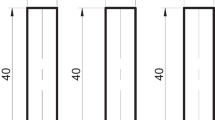Abstract
Metallic targets impacted by blunt-nosed projectiles typically fail via shear plugging. Various models exist that predict the onset of this failure threshold, which can be used to determine the ballistic limit velocity for a particular combination of projectiles and targets. In a previous study, nine existing penetration models were evaluated for their ability to predict the ballistic limit velocity of monolithic titanium alloy, aluminum alloy, and steel plates under small caliber fragment-simulating projectile impact. In a second study, a series of changes to these nine models were proposed, typically based on empirical adjustments, reformulation of the target strength dependency, or a combination of both. The effectiveness of these changes in improving the predictive capabilities of these nine models was assessed by comparing model predictions against more than 650 ballistic limit measurements. In this paper, we compare the ballistic limit velocities predicted by these nine models against ballistic limit measurements not included in the original 650 + dataset that guided the development of model improvements. It was found that the nine penetration models considered in these two previous studies are most suited for applications in which target plates can be considered “hard” or “high-strength.” In situations where target plates are made of “softer” materials, the predictive ability of these nine models was less than desirable.
Similar content being viewed by others
Data Availability
All data generated or analyzed during this study are included in this published article.
References
Schonberg WP, Ryan SJ (2021) Predicting metallic armour performance when impacted by fragment simulating projectiles – model review & assessment. Int J Impact Eng 158:104025
Schonberg WP, Ryan SJ (2022) Predicting metallic armour performance when impacted by fragment-simulating projectiles – model adjustments & improvements. Int J Impact Eng 161:104090
Awerbuch J (1970) A mechanics approach to projectile penetration. Isr J Technol 8:375–383
Nishiwaki J (1951) Resistance to the penetration of a bullet through an aluminum plate. J Phys Soc Jpn 6(5):374–378
Ipson TW, Recht RF (1977) Ballistic perforation by fragments of arbitrary shape, Report No. NWC TP 5927, Naval Warfare Center, Dahlgren
Forrestal MJ, Hanchak SJ (1999) Perforation experiments on HY-100 steel plates with 4340 R-38 and maraging T-250 steel rod projectiles. Int J Impact Eng 22:923–933
Ben-Dor G, Dubinsky A, Elperin T (2000) Optimization of the shape of a penetrator taking into account plug formation. Int J Fract 106:L29–L34
Chen XW, Li QM (2003) Perforation of a thick plate by rigid projectiles. Int J Impact Eng 28:743–759
Lambert JP (1978) The terminal ballistics of certain 65 gram long rod penetrators impacting steel armor plate, BRL-TR-02072, U.S. Army Ballistic Research Laboratory, Aberdeen Proving Ground, MD
Guo Z, Chen WW (2019) A predictive non-dimensional scaling law for the plate perforation of several aluminum alloys by fragment-simulating projectiles, Proceedings of the 2019 Hypervelocity Impact Symposium, Destin
Cimpoeru S (2002) Analytical modelling of the perforation of multi-layer metallic targets by fragment simulating projectiles, Proceedings of the 20th International Symposium on Ballistics, Orlando, p 778–785
Crouch IG, Baxter BJ, Woodward RL (1990) Empirical tests of a model for thin plate perforation. Int J Impact Eng 9(1):19–33
Goldsmith W, Finnegan SA (1986) Normal and oblique impact of cylindro-conical and cylindrical projectiles on metallic plates. Int J Impact Eng 4(2):83–105
Jenq ST, Goldsmith W, Kelly JM (1988) Effect of target bending in normal impact of a flat-ended cylindrical projectile near the ballistic limit. Int J Solids Struct 24(12):1243–1266
Liss J, Goldsmith W (1984) Plate perforation phenomena due to normal impact by blunt cylinder. Int J Impact Eng 2(1):37–64
Liu D, Stronge WJ (2000) Ballistic limit of metal plates struck by blunt deformable missiles: experiments. Int J Solids Struct 37:1403–1423
Woodward RL, de Morton ME (1976) Penetration of targets by flat-ended projectiles. Int J Mech Sci 18:119–127
Neilson AJ (1985) Empirical equations for the perforation of steel plates. Int J Impact Eng 3(2):137–142
Borvik T, Leinum JR, Solberg JK, Hopperstad OS, Langseth M (2001) Observations on shear plug formation in Weldox 460 E steel plates impacted by blunt-nosed projectiles. Int J Impact Eng 25(2001):553–572
Acknowledgements
The author gratefully acknowledges the support provided by the Fulbright Scholar Program that made this study possible.
Author information
Authors and Affiliations
Corresponding author
Ethics declarations
Competing Interests
The author declares no competing interests.
Additional information
Publisher’s Note
Springer Nature remains neutral with regard to jurisdictional claims in published maps and institutional affiliations.
Rights and permissions
About this article
Cite this article
Schonberg, W. A Comment on the Prediction of Metallic Plate Penetration by Fragment-Simulating Projectiles. Hum Factors Mech Eng Def Saf 6, 7 (2022). https://doi.org/10.1007/s41314-022-00048-x
Received:
Revised:
Accepted:
Published:
DOI: https://doi.org/10.1007/s41314-022-00048-x




